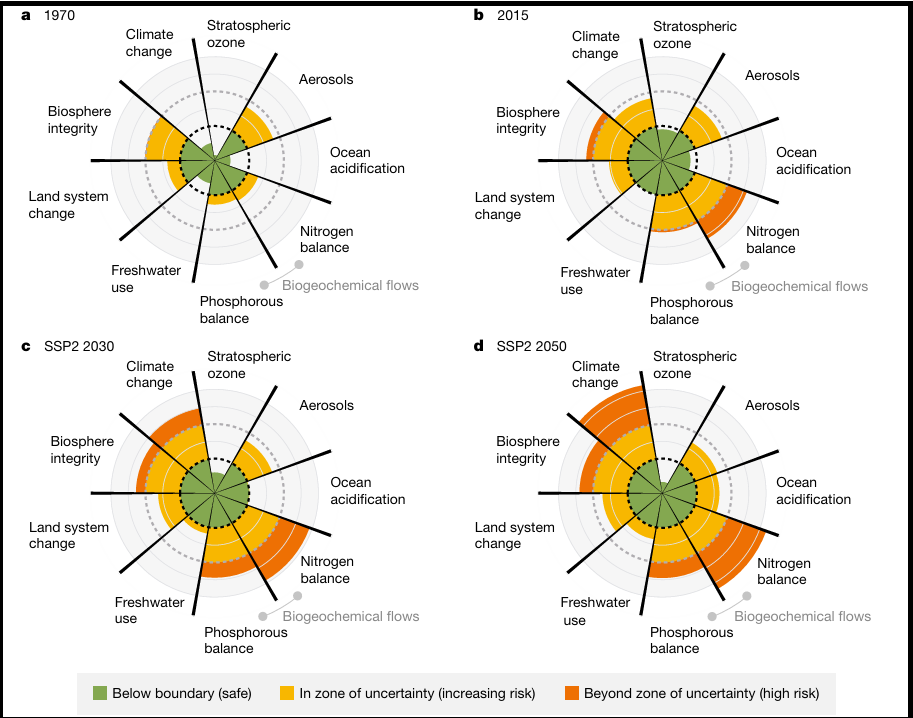Journal Article published by nature, May 2025.
Human activities have already pushed six of the nine planetary boundaries beyond their safe limits, threatening Earth’s long-term stability. This study integrates the planetary boundaries framework with scenario modelling using the Integrated Model to Assess the Global Environment (IMAGE), projecting the future of key Earth system processes under different policy choices.
Modelling a Dynamic Operating Space:
Unlike previous static analyses, this study dynamically assesses the nine planetary boundaries under varying socioeconomic and policy pathways to 2050 and 2100. Using Shared Socioeconomic Pathways (SSPs), the baseline scenario (SSP2) reflects current trajectories, while SSP1 and SSP3 represent more sustainable and pessimistic outlooks, respectively.
The control variables modelled include climate change, biosphere integrity, land-system change, ocean acidification, biogeochemical flows (nitrogen and phosphorus), atmospheric aerosols, freshwater use, and stratospheric ozone depletion. Projections reveal that without intervention, environmental degradation will continue across nearly all boundaries, with some entering high-risk zones especially climate change, nitrogen/phosphorus cycles, and biodiversity.

Limitations of Climate Policy Alone:
Implementing the Paris Agreement’s 1.5°C climate target alone (SSP2-1.9) helps reduce pressures on certain boundaries like air pollution and land-use change due to systemic shifts such as decarbonization and reforestation. However, climate policy by itself is insufficient to return the Earth system within safe limits by 2050 due to systemic inertia, trade-offs (like land demand for bioenergy), and delayed feedback from earlier overshoots.
A Sustainability Scenario for 2050 and Beyond:
A more comprehensive sustainability scenario explores a bundle of ambitious yet technically feasible measures:
- Adopting the EAT–Lancet planetary health diet
- Halving food waste
- Improving water-use efficiency across sectors
- Maximizing nitrogen-use efficiency
This integrated approach brings several boundaries such as biogeochemical flows, aerosols, and land-system change closer to 2015 levels or even better. However, even under this ambitious scenario, many boundaries remain transgressed in 2050, notably those influenced by inertia like climate change and biodiversity.
Long-term projections to 2100 show gradual improvement if current efforts are sustained, especially for climate and biodiversity, reinforcing the importance of early and sustained action. Indicators like aerosols and freshwater use respond more quickly due to lower biophysical inertia, while nutrient cycles and land use require more structural transformations.
Policy Relevance and Forward Directions:
The study underscores the value of aligning planetary boundary indicators with policy-relevant pressure variables, such as GHG emissions and fertilizer use. This helps translate abstract environmental thresholds into tangible policy targets.
However, societal feasibility remains a challenge. Implementing these transformations demands not just technological solutions but political will, public support, and equitable burden-sharing. The justice dimension of how costs and benefits are distributed must be central in future discussions.
This research article demonstrates that ambitious, integrated action can substantially mitigate environmental pressures and move the world closer to a safe operating space. However, partial efforts will fall short. Reaching and remaining within planetary boundaries requires urgent, holistic, and sustained global cooperation, well beyond climate targets alone.
This text is based on extracts from a journal article written by Detlef P. van Vuuren, Jonathan C. Doelman, Isabela Schmidt Tagomori, Arthur H. W. Beusen, Sarah E. Cornell, Johan Röckstrom, Aafke M. Schipper, Elke Stehfest, Geanderson Ambrosio, Maarten van den Berg, Lex Bouwman, Vassilis Daioglou, Mathijs Harmsen, Paul Lucas, Kaj-Ivar van der Wijst and Willem-Jan van Zeist, May 2025. The complete paper can be found here.
See below for our coverage on similar topics:
- Earth System Tipping Points Are a Threat to Europe – How to Get Prepared?
- EU-UNEP Initiative to Strengthen Food Security and Resilience in Sudan
- Tipping Point Costs Surge with Inaction



